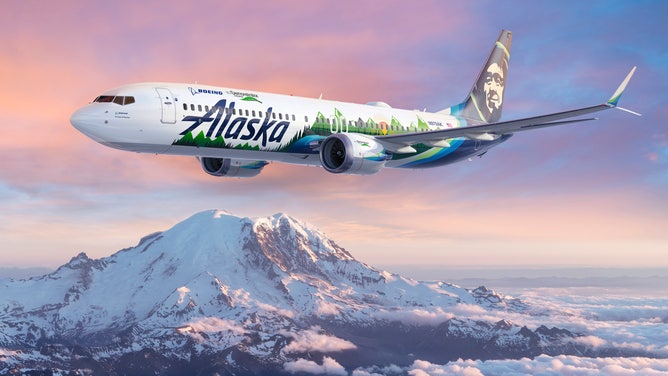NOAA, Boeing and Alaska Air team up to better measure greenhouse gas levels
Scientists with NOAA's Global Monitoring Laboratory will be installing air sampling instruments in three different locations and configurations on an Alaska Airlines Boeing 737-9 as part of Boeing’s 2021 ecoDemonstrator flying test bed program.

NOAA and Boeing are teaming up to evaluate the optimal placement of greenhouse-gas sampling inlets on a new 737-9 airliner owned by Alaska Air, depicted here over Mount Rainier, during Boeing's 2021 ecoDemonstrator technology testbed program.
(Boeing)
NOAA, Boeing and Alaska Airlines are teaming up to learn how best to use aircraft for collecting greenhouse gas samples in an effort to better monitor climate change.
Scientists with NOAA's Global Monitoring Laboratory will be installing air sampling instruments in three different locations and configurations on an Alaska Airlines Boeing 737-9 as part of Boeing’s 2021 ecoDemonstrator flying test bed program.
The goal is to use in-service commercial aircraft as an additional tool to measure greenhouse gases in the atmosphere, while keeping the data free from any emissions from the plane itself that could skew the results.
Air will be collected from a duct that feeds outside air into the airplane’s interior, and from two inlets mounted in a window plug for comparison, according to NOAA.
"Standardizing the location and installation of greenhouse gas monitoring instruments on commercial aircraft will be an important first step in expanding our sampling network to provide data for scientists and policymakers interested in understanding greenhouse gas emissions that are driving climate change," Colm Sweeney, lead scientist for the NOAA Global Monitoring Laboratory’s aircraft measurements program, said in a news release announcing the partnership.
NOAA keeps tabs on three critical drivers of climate change: carbon dioxide, methane and nitrous oxide, as well as carbon monoxide, which is an indicator of air pollution, NOAA says. The agency has four permanent observatories plus gathers measurements from 50 partner institutions and trained observers around the globe. In addition, NOAA has contracted with some private pilots to take air measurements.

NOAA's Global Greenhouse Gas Reference Network measures gas concentrations air samples from more than 50 ground based sampling locations around the world. NOAA also contracts with a small number of civilian pilots to collect airborne samples. Credit: NOAA Global Monitoring Laboratory
But this new project hopes to inject a new treasure trove of greenhouse gas data via commercial flights that would provide additional information to improve our long-range climate forecast models.
"Greenhouse gas measurements made from U.S. commercial airliners would help scientists verify the effectiveness of mitigation efforts in urban areas near major metropolitan airports, and changes in natural emissions coming from melting permafrost near remote airports in the high Arctic," said Kathryn McKain, the lead scientist for NOAA’s Commercial Aircraft Sampling Network.
The greenhouse gas measurements are just one of 20 different technologies that will be tested on the Alaska 737 as part of Boeing's annual ecoDemonstrator program.